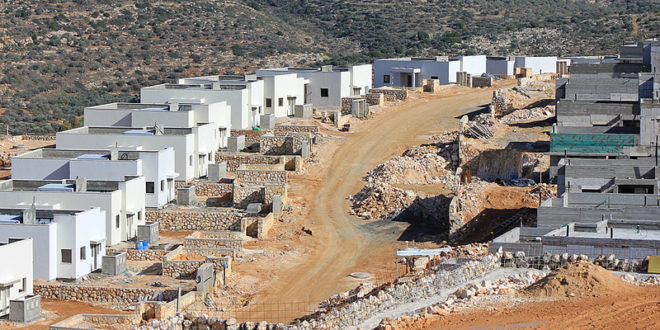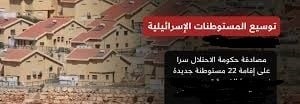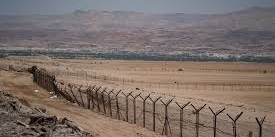By: Madeeha Araj,
Israeli Settlement’s creeping on the Palestinian lands has begun since the beginning of the year and doesn’t stop but takes unprecedented dimensions. Within the context, the Company for the Development of the Judean Mountains in cooperation with the Gush Etzion settlement council are working to establish 3 new settlements in Gush Etzion settlement. Moskowitz, who had previously participated in the settlements of Efrat and Alon Shvut settlements said that the establishment of those new settlementswill solve the problem of housing in Jerusalem.
There are 3 settlements near Jerusalem, near Alon Shvut, Gaf’ot and near the old settlement of Mesut Yitshak. The land on which the settlements will be built has different classifications by the occupying state. Some of them are under the control of the Israeli army. Former army minister, Moshe Yaalon, has agreed to evacuate them. The area is expected to be enough to establish 500 – 1000 housing units . Moskowitz claims that the old site of the settlement of Mesut Yitshak is belonging to a Jew before the establishment of Israel.
Plans are being made to build 500 housing units in the area. The final plan is the construction of the Gaf’ot town that was planned long ago. Moreover, the Ministry of Housing in coordination with the Gush Etzion Regional Council is planning a city to accommodate some 10,000 people. Moskovich claims that the 3 plans are located in the western Gush Etzion, meaning that they will remain under Israeli control within any political settlement.
This comes in conjunction with a decision by Israeli Defense Minister, Avigdor Lieberman to transfer land controlled by the army to the settlement of “Elad” in order to build 1000s of settlement units within the framework of the plans of the occupation state to erase the Green Line through the establishment and intensification of Jewish settlement blocs on both sides and to strengthen the Jewish settlement presence in those areas.
On the other hand, the Israeli occupation authorities approved the completion of constructing the segregation wall near the Ramallah city as it began erecting parts of it near Jenin. Israeli Security Minister, Lieberman approved the completion of the separation fence around the Beit El settlement in order to separate it from the Jalazoun Refugee Camp. Chairman of the Beit El settlement, Shay Alon said he was pleased with the Ministry of Army’ response to allocate NIS 5,000,000 for THE completion of the wall around Beit El. Within the context, the Israeli occupation forces isolated large areas of land in Jenin city with a barbed-wire fence. The 300-meter-long wall is being built along the road between Mreha and Ya’bad, which means isolating more of the lands behind the wall.
The Israeli occupation claims that the confiscation of Palestinian land on which settlement structures have been built is a “fair and reasonable humanitarian response” to what it allegedly named a “hardship” suffered by settlers in settlements on the occupied West Bank. Within the context, the Israeli Public Prosecution filed an initial response to the petitions filed by Palestinians and human rights organizations against the confiscation law, which allows for the confiscation of private Palestinian land on which settlement buildings were built. The petitions were rejected on the grounds that “the confiscation is a fair and reasonable humanitarian response due to a real hardship. The Israeli government is trying to present the confiscation law in response to a national problem, while in fact it is a continuation of the government’s support for a colonial and current settlement project that has continued for scores of years. It tries to show Israelis who confiscate the land as losers, who need to be compensated.
Hebrew sources revealed the so-called Civil Administration’s confession of the existence of 3455 settlement units in the West Bank erected on land owned by Palestinian citizens through the response provided by the State and the Civil Administration. According to the Civil Administration, 3455 settlement units are divided into 3 areas. The first includes 1285 settlement units built on lands owned by Palestinians. The second includes 1,048 settlement units built by mistake on Palestinian land. The third includes 1,222 settlement units existing 22 years ago. It also turns out that of the 1285 settlement units that were built on private Palestinian land, of them 543 are based on private land registered and recognized even by the civil administration.
The same sources claimed that the Israeli occupation authorities are in the process of approving the law of “settlement organization” which authorizes the establishment of about 4000 new settlement units in the West Bank and occupied Jerusalem. The law of “settlement organization” which legislates the seizure of private Palestinian property conforms to Israeli and international legal standards, That the Attorney General “Avihai Mandelblit” appealed to the Supreme Court of Justice by 13 non-governmental groups against the law. The law permits the establishment of some 4,000 new settlement units to be built on private Palestinian property, while Palestinian landowners will be financially compensated.
On the other hand, Judaization of the settlements continues in the Jerusalem city. Minister of Agriculture, Uri Ariel, Knesset members and rabbis, and about 300 settlers opened a synagogue in Batn Al-Hawa neighborhood, which was confiscated in 2015, and they entered 2 Torah books in it. The settlement societies claim that the property was in the late 19th century a synagogue for the Yemen Jews, thus began to demand the evacuation of the property since 2004. The property is located within the scheme of Ateret Kohenim to control 5 donums and 200 sq.m since 1881.
Meanwhile, Arieh King, director of the so-called the Land Fund of Israel, claimed that over the next decade, 400 Jewish families would settle in Jerusalem’s Sheikh Jarrah neighborhood. King said the Sheikh Jarrah neighborhood would undergo a “revolution,” adding that his organization is currently working on 4 settlement communities. In the next stage, Jewish families are planned to be housed in 2 other communities, one consisting of 300 settlement units and the other of 200 settlement units. Currently, there are 5 Jewish buildings in the neighborhood, and the settlement activity in the area is intended to connect Mmount Scobbs with St. No. 1 and the Mina Sharim neighborhood.
The National Bureau for Defending Land and Resisting Settlements has denounced members of the “Knesset” and rabbis for opening a synagogue in the Battn Al-Hawa neighborhood in the Silwan town, south of Al-Aqsa Mosque, on a property brought under control in 2015, moreover, the introduction of 2 books of the Torah. The Bureau considered such a step as imposing a de-facto position on the ground to completely juadize the Holy City.
The National Bureau also condemned the continued Israeli occupation repressive and colonial measures aimed at striking the educational process in Palestine and particularly in areas classified as area C, where the occupation captured mobile homes belonging to Jib Deib school east of Bethlehem, under the pretext of not being licensed. Moreover, the occupation forces demolished a kindergarten at Jabal-Baba in Ezzariya, financed by the EU, which includes about 25 children under the age of 5 years, under the same pretext. They also dismantled and confiscated solar panels, the only source of power for Abu- Nowar School, adding that the school was twice exposed to attack last year.
The National Bureau documented the following Israeli Occupation and Settlers’ Violations during the last week:
Jerusalem:
- Demolishing a kindergarten fat Jabal Al-Baba in the Eizariya town, and confiscated all its contents.
- Demolishing orders of houses belonging to Bedouin living in the area, despite the high court’s resolution to freeze the demolition orders in it. The occupation is doing so in order to use the land of the Jabal Baba in favor of settlement project known as “E1”, which would separate Jerusalem completely from the rest of the Palestinian territories.
- Demolishing a house belonging to Abd-Karim Abu Sneineh at the Bustan neighborhood in the Silwan town, which was recently built by Abu Sneineh family and a number of solidarity activists, under the pretext of building without a license.
- Preparing to demolish the Yusifiya cemetery wall in order to seize the land of the cemetery to establish biblical gardens.
- Approving a large building plan on the main road near Beit Safafa, to intensify construction along the light rail tracks. The plan includes the construction of scores of settlement buildings, as well as 2 commercial buildings in Sderot Dov Yosef towards the road that leads up to Gilo. Those projects are to be attached to Pisgat Zeev and Givat Shaul settlements.
- Handing over summons orders to a number of homeowners in several neighborhoods of Silwan in order to inform them regarding the demolition orders for their houses because they were built without licenses.
Hebron:
- Attacking a number of houses in the Wadi Husain area in Hebron, breaking into some houses and searching them.
- Bulldozing lands adjacent to the Karmiel settlement in order to expand it at the expense of Palestinian lands to east of Yatta town, hitting an old man named, Suleiman Al-Hathalin, holding him for several hours after being handcuffed.
Bethlehem:
- Bulldozing agricultural land in the Al-Jab’a village in Bethlehem Governorate, the land belonging to the Masha’leh family, besides, bulldozing a land for training military camp in an area South of Bethlehem, and confiscating scores of donams of Palestinian land in the village.
- Demolishing the Jib Al-Dhib school near the village of Al-Fardis, east of Bethlehem, and confiscating the classrooms, which are “caravans” under the pretext of being erected in a closed military zone.
- Invading the Za’tara and Jib Al-Dhib villages and prevented people from approaching the school.
Ramallah:
- Preventing Palestinian citizens of the Barham and Jibiya villages, north of Ramallah, from reaching Jebia Natural Reserve. Invading the villages and protected settlers to enter them. Israeli army and settlers fired rubber and live bullets, and tear gas at the youths and some houses, which caused a number of suffocations among the citizens and the neighboring villages.
Salfit:
- Imposing a curfew on the Haris town to facilitate the entry of hundreds of extremist settlers to the town to perform some of the Jewish Talmudic rituals. Moreover, hundreds of Israeli settlers stormed the religious sanctuaries in the Kafl Hares town 5 km north of Salfit, where settlers tried to convert those shrines into biblical shrines and organize periodic visits to them.
- Carrying out a new settlement operation in the area of Izbat Abu-Basal, west of Salfit, in favor of the factories of the Ariel settlement.
Jenin:
- Building parts of the annexation wall on the land of the Ya’bad town, with 300 meters in the agricultural land, fearing that the occupation forces will isolate the land behind the wall, which will deprive Palestinians from reaching their land and preventing their entry, especially near the settlement of “Mapodothan” built on their land.
Jordan Valley:
- Informing farmers in the Bardala village in the Northern of the Jordan Valley that they denied access to their agricultural land on the Qa’oun plain, under the pretext of being closed military zones.
 المكتب الوطني للدفاع عن الارض ومقاومة الاستيطان منظمة التحرير الفلسطينية
المكتب الوطني للدفاع عن الارض ومقاومة الاستيطان منظمة التحرير الفلسطينية




